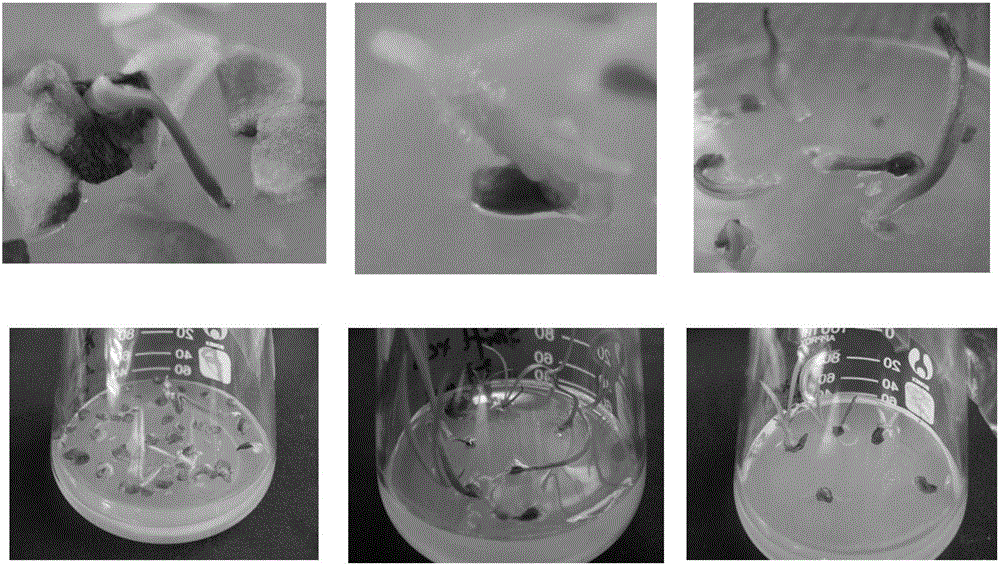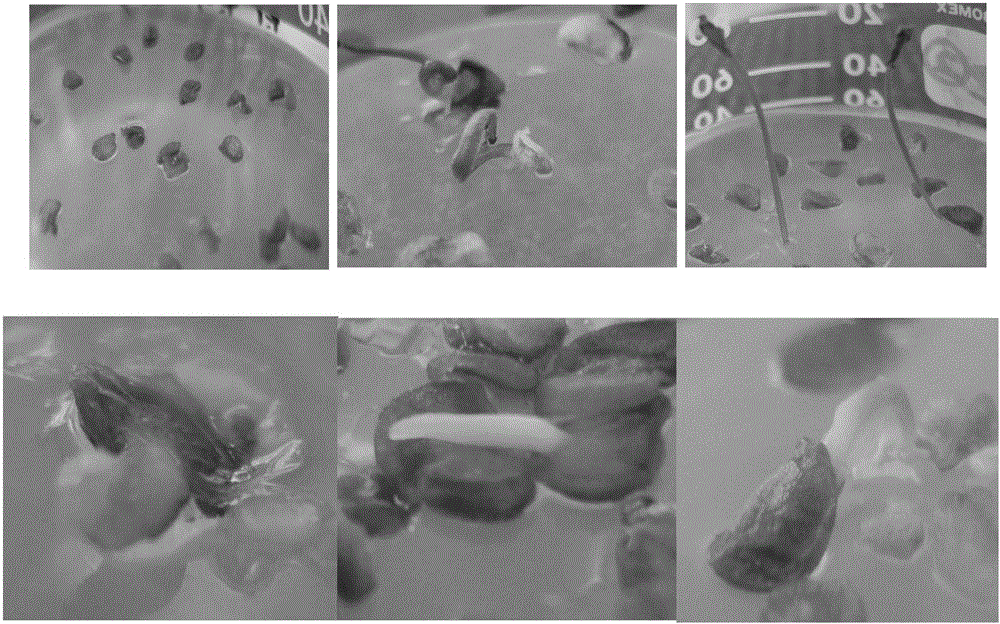Method for embryo rescue at different developmental stages of early phase of lilium formolongi distant hybridization
A new iron cannon lily and developmental stage technology is applied in the field of embryo rescue at different developmental stages in the early stage of distant hybridization of new iron cannon lily, and can solve problems such as single flower color and pattern, obstacles after fertilization, etc.
- Summary
- Abstract
- Description
- Claims
- Application Information
AI Technical Summary
Problems solved by technology
Method used
Image
Examples
Embodiment 1
[0033] Example 1 Screening of ovary slice culture conditions in different periods of early pollination 5d-25d
[0034] 1. Materials and methods
[0035] (1) Extract the ovaries of the new Iron Pao Lily 'Augusta' as the female parent and the Oriental Lily 'Sorbonne' as the male parent, 5d, 10d, 15d, 20d, 25d after pollination; (2) the extracted ovaries Use a cotton ball dipped in alcohol with a volume percentage of 75% to wipe the surface for disinfection, soak in sodium hypochlorite with 1% available chlorine for 20 minutes, shake the container while soaking to make it fully contact; then rinse with sterile water 3 times, 2 minutes each time (3) cut the ovary into 2-3mm thin slices with a sharp scalpel and place them horizontally on the medium; (4) the medium formula for screening is basic medium B 5 , 1 / 2B 5 , MS, 1 / 2MS (pH=5.8, agar mass percentage concentration 0.8%) were added 3%, 6%, 9% or 12% sucrose with different mass percentage concentrations respectively to form a ...
Embodiment 2
[0041] Example 2 Ovary Slice Culture Obtained Embryo Ovule Culture Condition Screening in Vitro
[0042] 1. Materials and methods
[0043] (1) Inoculate the embryonic ovules obtained under the optimal conditions of ovary culture in different periods in Example 1 into corresponding and consistent medium to continue to cultivate; (2) The medium formula is consistent with the previous ovary slice culture, that is, basically Medium B 5 , 1 / 2B 5 , MS, 1 / 2MS (pH=5.8, agar mass percentage concentration 0.8%) were added with 3%, 6%, 9% or 12% sucrose with different mass percentage concentrations respectively to form a total of 12 treatment combinations for screening suitable for different The best medium formula for further culture of embryonic ovules obtained during this period; (3) The culture conditions are 25±1°C, dark culture, and the seedling formation of ovules is observed and counted.
[0044] 2. Results and Analysis
[0045] Table 2. Screening results of culture condition...
Embodiment 3
[0050] 35d-40d ovule direct in vitro culture condition screening after pollination of embodiment 3
[0051] 1. Materials and methods
[0052] (1) Extract the new iron gun lily 'Augusta' as the female parent, and the Oriental lily 'Sorbonne' as the male parent, and the ovary of 35d-40d after pollination; (2) the extracted ovary under sterile conditions Wipe the surface with 75% volume percent alcohol cotton ball for 3 times, soak in sodium hypochlorite with 1% available chlorine for 20 minutes, and rinse with sterile water for 3 times; Screening medium. (4) The formula of the screening medium is MS as the basic medium, and the mass percentage concentration of agar is 0.8%. Different concentrations of NAA, sucrose and medium pH are screened, and the results of different treatments are analyzed by range analysis and variance analysis . (5) The culture temperature is 25±1° C., dark culture, and each treatment is repeated 3 times, with 20-30 ovules per repetition.
[0053] 2. R...
PUM
 Login to View More
Login to View More Abstract
Description
Claims
Application Information
 Login to View More
Login to View More - R&D
- Intellectual Property
- Life Sciences
- Materials
- Tech Scout
- Unparalleled Data Quality
- Higher Quality Content
- 60% Fewer Hallucinations
Browse by: Latest US Patents, China's latest patents, Technical Efficacy Thesaurus, Application Domain, Technology Topic, Popular Technical Reports.
© 2025 PatSnap. All rights reserved.Legal|Privacy policy|Modern Slavery Act Transparency Statement|Sitemap|About US| Contact US: help@patsnap.com



